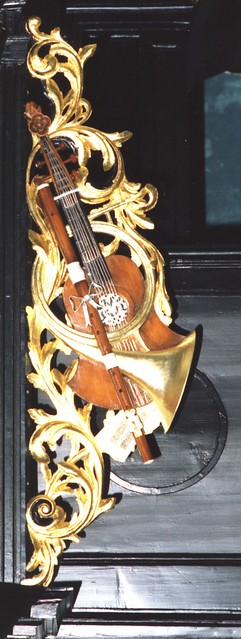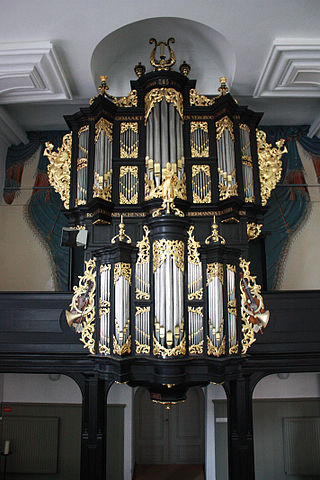A  few weeks ago I found this book in a secondhand bookshop in Utrecht. My first attention was drawn to the name “Hinsz”, as one of the most prominent makers of the English Guittar was named “Hintz”. The instrument statue on the organ in the church of Langbroek shows similarities with those of Hintz. Anyone who has ever studied history will know that names were often misspelled, even by their bearers.
few weeks ago I found this book in a secondhand bookshop in Utrecht. My first attention was drawn to the name “Hinsz”, as one of the most prominent makers of the English Guittar was named “Hintz”. The instrument statue on the organ in the church of Langbroek shows similarities with those of Hintz. Anyone who has ever studied history will know that names were often misspelled, even by their bearers.
 So my interest was awakened. When I opened the book some other things struck me. The stylistic similarities of the anonymous organ chest of Langbroek (it was purchased secondhand and in 1809 J.C. Friedrichs built the present organ in it) and those by Hinsz. The form of the central and side towers, the decoration… While leafing trough the book other things caught my eye, and my final conclusion was to buy the book. When you leave a find like that in the shop thinking ‘that will come later’, at the next visit it will be gone and you will probably spend the rest of your life searching for that book…
So my interest was awakened. When I opened the book some other things struck me. The stylistic similarities of the anonymous organ chest of Langbroek (it was purchased secondhand and in 1809 J.C. Friedrichs built the present organ in it) and those by Hinsz. The form of the central and side towers, the decoration… While leafing trough the book other things caught my eye, and my final conclusion was to buy the book. When you leave a find like that in the shop thinking ‘that will come later’, at the next visit it will be gone and you will probably spend the rest of your life searching for that book…

An English Guittar made by J.F. Hintz
The first thing I learned from the book is that organ maker Albertus Anthoni Hinsz was born in Hamburg in 1704 as son of furniture maker Hinrich Hins. The family name is found in the archives there in various spellings: Hins, Hinse, Hinsche, Hints, Hintsche, Hinsz, Hinsze, Hintz (!), Hinz and Hinze. Something that stands out is that between 1694 and 1723 there were 23 children baptized that had a certain ‘Hinrich Hins’ as father, the name of the mother wasn’t mentioned, so it is possible that there were more than one or even multiple men with that name. Unfortunately the writer doesn’t mention wherether there was a baby brother named John Frederick born in 1711 who later joined the Moravian Brotherhood. John Frederick Hintz would become a furniture maker, who had a close friendship with the famous Roentgen family and later start making musical instruments. There lies a nice loose end to investigate…
Another thing that the book told me was that the organ chests were usually made by local carpenters, after a sketch the organ maker supplied. Additional leaf-work and other decoration were bought from external woodcarvers. This doesn’t answer all my questions involving the English Guittar on the Langbroek organ. Were the statues with the organ case when it was bought? And who made them? Were they perhaps made by a woodcarver from the Moravian Church, as they had a rich tradition in woodworking?
Another thing that caught my eye in the bookshop was a picture of this organ. Hinsz made it in 1774 for the “Pelstergasthuis” in Groningen.
Take a look at the side decorations of the ‘backwork’ of the organ… On the right we see a violin, caught by a horn. But on the left there is a plucked instrument, with a belly shaped like a bell…
 This is a representation of a ‘Hamburger Cithrinchen’ or ‘Bell-Cittern’. As the name suggests these instruments were mainly made and played around Hamburg (also the place were organ maker Hinsz was born).
This is a representation of a ‘Hamburger Cithrinchen’ or ‘Bell-Cittern’. As the name suggests these instruments were mainly made and played around Hamburg (also the place were organ maker Hinsz was born).
The most prolific ‘maker’ who left most examples of this instruments was the famous Joachim Tielke (1641-1719).
I put “maker” in quotes, because Tielke was most likely an entrepreneur, who commissioned instruments from other makers and sold them under his own brand name, or the leader of a large atelier in which instruments were made. Tielke studied medicine at the Dutch university of Leiden, and later married the daughter of Hamburg instrument maker Christoph Fleischer. If we regard the extreme amount of decoration and massive output of his workshop it’s almost impossible that he made all these instruments himself.
It’s easy to recognize Tielke instruments; on a quiet day his workers made ivory inlays in ebony, and on a busy day they put ebony or tortoise inlays into ivory… Today it would be nearly impossible to get one of his instruments through the customs at an airport…
But not all these Cithrinchen were so over-decorated. Witness this example by Hinrich Kopp (Hamburg 1686), made with a VERY wide grained soundboard (one of my personal favourites).
As you can see this is an ongoing project, a journey after the wonders and strange members of the plucked instrument family. I do this purely to satisfy my own curious mind and don’t know where it will lead to. Until now it already has brought me to the most strange places I’d never wondered to go. Standing on a wobbly scaffolding in the top of a church, measuring a statue of an instrument. Studying thick reports about the lives and work of makers of almost forgotten instruments.
Although the Cithrinchen in Groningen is a flat wooden depiction of a real instrument, it still is a nice footnote in the history of Dutch music. Maybe someday I will make a reconstruction, it would be a nice excuse to travel to Groningen and also visit Hinsz’ grave in the Lutheran church…





